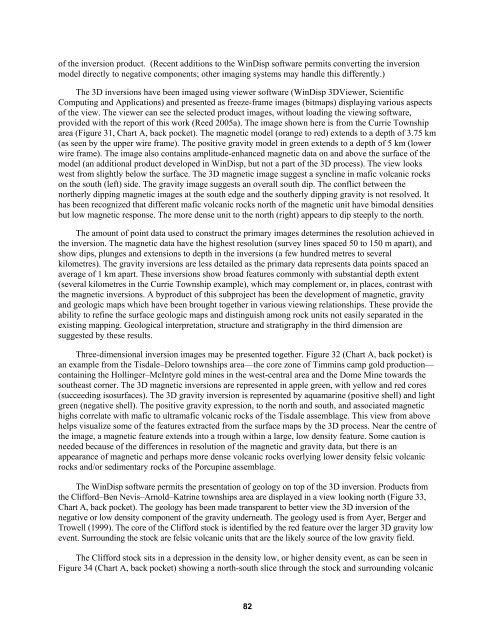Overview of Results from the Greenstone ... - Geology Ontario
Overview of Results from the Greenstone ... - Geology Ontario
Overview of Results from the Greenstone ... - Geology Ontario
Create successful ePaper yourself
Turn your PDF publications into a flip-book with our unique Google optimized e-Paper software.
<strong>of</strong> <strong>the</strong> inversion product. (Recent additions to <strong>the</strong> WinDisp s<strong>of</strong>tware permits converting <strong>the</strong> inversion<br />
model directly to negative components; o<strong>the</strong>r imaging systems may handle this differently.)<br />
The 3D inversions have been imaged using viewer s<strong>of</strong>tware (WinDisp 3DViewer, Scientific<br />
Computing and Applications) and presented as freeze-frame images (bitmaps) displaying various aspects<br />
<strong>of</strong> <strong>the</strong> view. The viewer can see <strong>the</strong> selected product images, without loading <strong>the</strong> viewing s<strong>of</strong>tware,<br />
provided with <strong>the</strong> report <strong>of</strong> this work (Reed 2005a). The image shown here is <strong>from</strong> <strong>the</strong> Currie Township<br />
area (Figure 31, Chart A, back pocket). The magnetic model (orange to red) extends to a depth <strong>of</strong> 3.75 km<br />
(as seen by <strong>the</strong> upper wire frame). The positive gravity model in green extends to a depth <strong>of</strong> 5 km (lower<br />
wire frame). The image also contains amplitude-enhanced magnetic data on and above <strong>the</strong> surface <strong>of</strong> <strong>the</strong><br />
model (an additional product developed in WinDisp, but not a part <strong>of</strong> <strong>the</strong> 3D process). The view looks<br />
west <strong>from</strong> slightly below <strong>the</strong> surface. The 3D magnetic image suggest a syncline in mafic volcanic rocks<br />
on <strong>the</strong> south (left) side. The gravity image suggests an overall south dip. The conflict between <strong>the</strong><br />
nor<strong>the</strong>rly dipping magnetic images at <strong>the</strong> south edge and <strong>the</strong> sou<strong>the</strong>rly dipping gravity is not resolved. It<br />
has been recognized that different mafic volcanic rocks north <strong>of</strong> <strong>the</strong> magnetic unit have bimodal densities<br />
but low magnetic response. The more dense unit to <strong>the</strong> north (right) appears to dip steeply to <strong>the</strong> north.<br />
The amount <strong>of</strong> point data used to construct <strong>the</strong> primary images determines <strong>the</strong> resolution achieved in<br />
<strong>the</strong> inversion. The magnetic data have <strong>the</strong> highest resolution (survey lines spaced 50 to 150 m apart), and<br />
show dips, plunges and extensions to depth in <strong>the</strong> inversions (a few hundred metres to several<br />
kilometres). The gravity inversions are less detailed as <strong>the</strong> primary data represents data points spaced an<br />
average <strong>of</strong> 1 km apart. These inversions show broad features commonly with substantial depth extent<br />
(several kilometres in <strong>the</strong> Currie Township example), which may complement or, in places, contrast with<br />
<strong>the</strong> magnetic inversions. A byproduct <strong>of</strong> this subproject has been <strong>the</strong> development <strong>of</strong> magnetic, gravity<br />
and geologic maps which have been brought toge<strong>the</strong>r in various viewing relationships. These provide <strong>the</strong><br />
ability to refine <strong>the</strong> surface geologic maps and distinguish among rock units not easily separated in <strong>the</strong><br />
existing mapping. Geological interpretation, structure and stratigraphy in <strong>the</strong> third dimension are<br />
suggested by <strong>the</strong>se results.<br />
Three-dimensional inversion images may be presented toge<strong>the</strong>r. Figure 32 (Chart A, back pocket) is<br />
an example <strong>from</strong> <strong>the</strong> Tisdale–Deloro townships area—<strong>the</strong> core zone <strong>of</strong> Timmins camp gold production—<br />
containing <strong>the</strong> Hollinger–McIntyre gold mines in <strong>the</strong> west-central area and <strong>the</strong> Dome Mine towards <strong>the</strong><br />
sou<strong>the</strong>ast corner. The 3D magnetic inversions are represented in apple green, with yellow and red cores<br />
(succeeding isosurfaces). The 3D gravity inversion is represented by aquamarine (positive shell) and light<br />
green (negative shell). The positive gravity expression, to <strong>the</strong> north and south, and associated magnetic<br />
highs correlate with mafic to ultramafic volcanic rocks <strong>of</strong> <strong>the</strong> Tisdale assemblage. This view <strong>from</strong> above<br />
helps visualize some <strong>of</strong> <strong>the</strong> features extracted <strong>from</strong> <strong>the</strong> surface maps by <strong>the</strong> 3D process. Near <strong>the</strong> centre <strong>of</strong><br />
<strong>the</strong> image, a magnetic feature extends into a trough within a large, low density feature. Some caution is<br />
needed because <strong>of</strong> <strong>the</strong> differences in resolution <strong>of</strong> <strong>the</strong> magnetic and gravity data, but <strong>the</strong>re is an<br />
appearance <strong>of</strong> magnetic and perhaps more dense volcanic rocks overlying lower density felsic volcanic<br />
rocks and/or sedimentary rocks <strong>of</strong> <strong>the</strong> Porcupine assemblage.<br />
The WinDisp s<strong>of</strong>tware permits <strong>the</strong> presentation <strong>of</strong> geology on top <strong>of</strong> <strong>the</strong> 3D inversion. Products <strong>from</strong><br />
<strong>the</strong> Clifford–Ben Nevis–Arnold–Katrine townships area are displayed in a view looking north (Figure 33,<br />
Chart A, back pocket). The geology has been made transparent to better view <strong>the</strong> 3D inversion <strong>of</strong> <strong>the</strong><br />
negative or low density component <strong>of</strong> <strong>the</strong> gravity underneath. The geology used is <strong>from</strong> Ayer, Berger and<br />
Trowell (1999). The core <strong>of</strong> <strong>the</strong> Clifford stock is identified by <strong>the</strong> red feature over <strong>the</strong> larger 3D gravity low<br />
event. Surrounding <strong>the</strong> stock are felsic volcanic units that are <strong>the</strong> likely source <strong>of</strong> <strong>the</strong> low gravity field.<br />
The Clifford stock sits in a depression in <strong>the</strong> density low, or higher density event, as can be seen in<br />
Figure 34 (Chart A, back pocket) showing a north-south slice through <strong>the</strong> stock and surrounding volcanic<br />
82

















